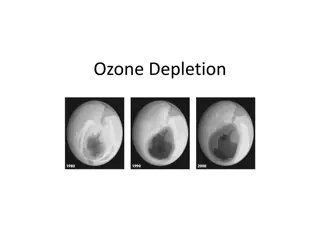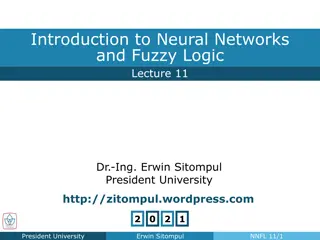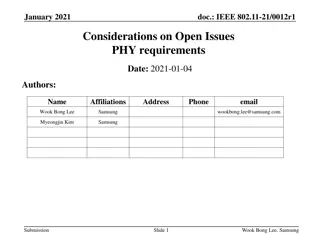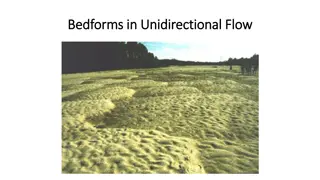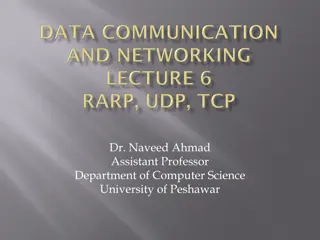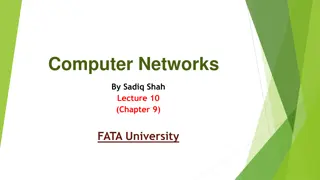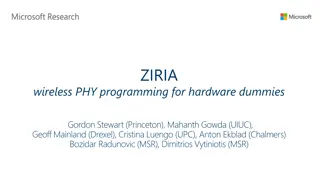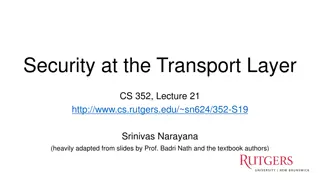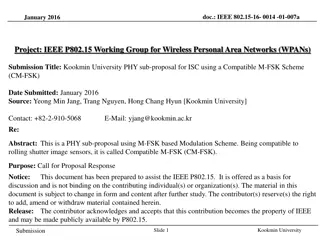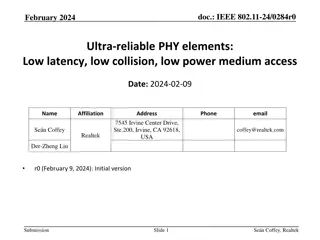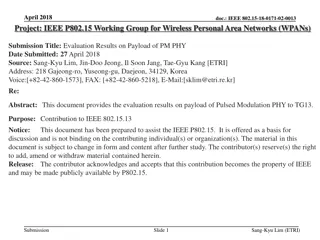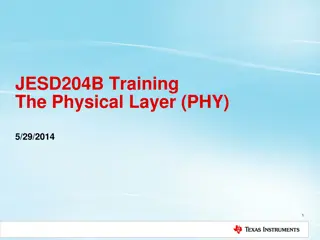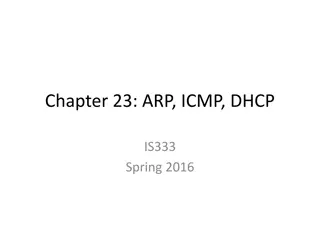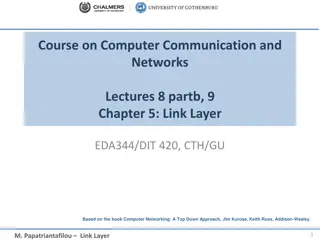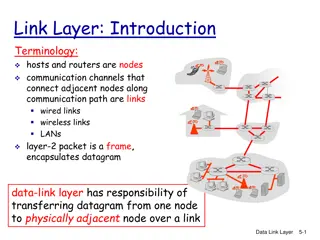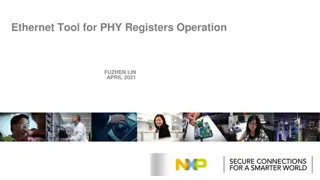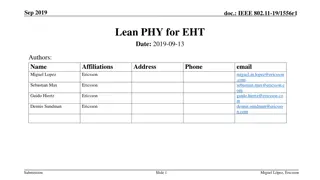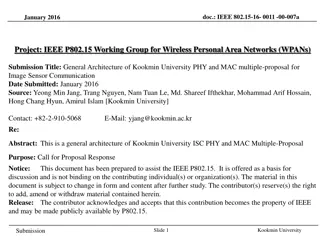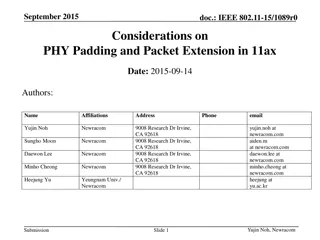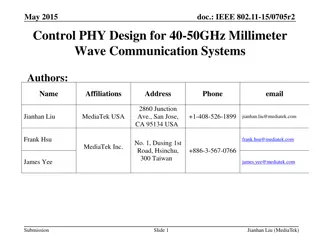Automated Mobile App QoE Diagnosis with Cross-layer Analysis
This work presents the QoE Doctor, a solution for accurate and repeatable QoE measurements and analysis in mobile apps. By introducing UI automation, it enables the replay of user behavior to measure UI layer QoE metrics without modifying app source code. The QoE Doctor also supports multi-layer dia
3 views • 28 slides
Layer 2 Token Marketing Services
Layer-2 token marketing promotes tokens built on scalable layer-2 solutions, highlighting benefits like faster transactions and lower fees. Get connected with our experts today and launch a lucrative \ntoken platform.
0 views • 3 slides
Understanding Ozone Depletion: Causes and Impact
The ozone layer, found in the stratosphere at 15 to 40 km altitude, plays a crucial role in absorbing harmful ultraviolet radiation. However, due to the use of Chlorofluorocarbons (CFCs), the ozone layer has been depleted, leading to the formation of the ozone hole. This depletion is caused by chemi
0 views • 27 slides
Understanding Multi-Layer Perceptrons in Neural Networks
In this lecture by Dr. Erwin Sitompul at President University, the focus is on Multi-Layer Perceptrons (MLP) in neural networks, discussing their architecture, design considerations, advantages, learning algorithms, and training process. MLPs with hidden layers and sigmoid activation functions enabl
2 views • 17 slides
NASA Platform Layer Updates for the CAELUM (7.0) Release
The National Aeronautics and Space Administration (NASA) discusses platform layer updates for the CAELUM (7.0) release of the Core Flight System in the 2021 Flight Software Workshop. The platform layer consists of the Operating System Abstraction Layer (OSAL) and Platform Support Package (PSP), whic
1 views • 20 slides
Understanding Communication Layers in Computer Networks
Communication in computer networks is facilitated through different layers such as the data link, network, and transport layers. Each layer has specific responsibilities in ensuring data delivery from one point to another. The data link layer handles communication between adjacent nodes, the network
3 views • 7 slides
IEEE 802.11-20/0095 PHY-Related Agreements for SST
IEEE 802.11-20/0095 outlines agreements related to PHY aspects impacting the definition of Spatial Stream Tapping (SST) in 802.11 standards. The focus is on enabling 80 MHz operating stations to participate in 160 MHz OFDMA, including in non-primary 80 MHz scenarios. Various considerations and scena
1 views • 11 slides
Understanding Boundary Layer and Drag Forces in Fluid Dynamics
Boundary layer module explains the presence of viscous forces near a surface due to fluid flow, leading to laminar or turbulent boundary layers. Flow separation occurs when a boundary layer detaches from a surface, impacting lift and drag forces. Adverse pressure gradients and flow separation phenom
0 views • 19 slides
IEEE 802.11-21/0012r1 Considerations on Open Issues in PHY Requirements
In the January 2021 document IEEE 802.11-21/0012r1, discussions were held on open issues related to PHY requirements, including LO requirements for 320 MHz transmission, EVM requirements for 1024 QAM and BPSK-DCM-DUP, minimum sensitivity for 4K QAM and BPSK-DCM-DUP, and channel rejection levels. Sug
0 views • 12 slides
Understanding Paper and Thin Layer Chromatography (TLC) in Biochemistry
Chromatography techniques are used in laboratories to separate and identify components of mixtures. Paper chromatography is a type where a developing solution travels up a filter paper, separating compounds based on their affinity to the stationary phase. Thin Layer Chromatography (TLC) is a similar
0 views • 22 slides
Considerations on PHY for 60 GHz in IEEE 802.11-22/1865r0 Document
The document discusses the possibility of standardizing multi-link (ML) with bands in the sub-7 GHz range combined with bands in the 45-72 GHz range, proposing reusing a sub-7 GHz PHY for mmWave bands. It explores the impact of phase noise on choosing the OFDM numerology for operation in the 45-72 G
1 views • 13 slides
Understanding the OSI Model and Layered Tasks in Networking
The content highlights the OSI model and layered tasks in networking, explaining the functions of each layer in the OSI model such as Physical Layer, Data Link Layer, Network Layer, Transport Layer, Session Layer, Presentation Layer, and Application Layer. It also discusses the interaction between l
1 views • 41 slides
Bedforms in Unidirectional Flow: Characteristics and Formation
Bedforms in unidirectional flow exhibit various characteristics such as sediment layer thicknesses, boundary layer dynamics, presence of ripples and dunes, and the interplay between flow velocity and sediment deposition. These bedforms, including ripples and dunes, form due to interactions between t
3 views • 13 slides
Understanding RARP and Transport Layer in Computer Networking
Exploring Reverse Address Resolution Protocol (RARP) for mapping physical addresses to logical addresses in networking, along with insights on the Transport Layer's role in providing communication services to application processes. Learn about RARP packet formats, encapsulation, and the significance
0 views • 41 slides
Understanding Internet Transport Layer Services and Protocols
In the realm of networking, exploring the principles of transport layer services is crucial. This involves concepts like multiplexing/demultiplexing, reliable data transfer, flow control, and congestion control, which are facilitated by protocols such as UDP and TCP. The transport layer acts as a br
0 views • 56 slides
Understanding Data Link Layer Communication in Computer Networks
Exploring the data link layer in computer networks, this lecture discusses the node-to-node communication, services provided, such as framing, flow control, error control, and congestion control. Through a series of images, the concept of links and nodes, as well as the responsibilities of the data
0 views • 16 slides
Understanding Data Link Layer in Computer Networking
The Data Link Layer (DLL) is the second layer of the OSI model, responsible for error detection and correction, framing, addressing, synchronization, flow control, and multi-access protocols. It deals with logical link control and media access control, addressing destination hardware, avoiding data
0 views • 49 slides
Enhancements to International Survey of Herbicide Resistant Weeds and Website Overhaul Plan
In 2019, Ian Heap, Director of the International Survey of Herbicide Resistant Weeds (HRAC), is leading an initiative to enhance the survey and overhaul the website to target completion by year-end. The website will undergo a three-tiered redesign focusing on presentation layer, application layer, a
0 views • 11 slides
Innovations in Wireless PHY Programming for Hardware
Programming software radios is a key aspect of wireless communication research, with recent advancements in PHY/MAC design and the use of SDR platforms like GNURadio and SORA for experimentation. Challenges include FPGA limitations and the need for hardware synthesis platforms like ZIRIA for high-le
0 views • 41 slides
Meridian: An SDN Platform for Cloud Network Services
Meridian is an SDN platform developed by Mohammad Banikazemi, David Olshefski, Anees Shaikh, John Tracey, and GuohuiWang at IBM T. J. Watson Research Center. The platform focuses on providing cloud network services efficiently. It encompasses an architecture that enables faster and more convenient n
0 views • 21 slides
Understanding ZFS: Structure and Operations
Explore the comprehensive structure and operations of ZFS, covering aspects like MOS layer, object-set layer, Dnode, Block Pointer, and TRIM operations. Learn about the meta-object set (MOS), dataset and snapshot layer (DSL), and storage pool allocator (SPA) modules within ZFS. Understand how ZVOLs,
0 views • 10 slides
Understanding the Planetary Boundary Layer in Atmospheric Science
The Planetary Boundary Layer (PBL) plays a crucial role in atmospheric dynamics, divided into surface, mixed, stable, and residual layers. During the day, the mixed layer experiences convective motions due to surface heating, while the stable layer dominates during the night. Understanding these lay
0 views • 18 slides
Understanding Transport Layer Security (TLS) and Secure Sockets Layer (SSL)
This content delves into the concepts of Transport Layer Security (TLS) and Secure Sockets Layer (SSL), exploring their origins, application in web security, and protocol stack integration. It covers the TLS/SSL handshake process, key derivation, data transfer mechanisms, and the significance of the
0 views • 26 slides
Kookmin University PHY Sub-Proposal for ISC Using CM-FSK Scheme
Kookmin University submitted a PHY sub-proposal for an ISC using a Compatible M-FSK (CM-FSK) scheme to the IEEE P802.15 Working Group for WPANs. The proposal aims to be compatible with rolling shutter image sensors by utilizing the CM-FSK modulation scheme. Design considerations include frame rate v
0 views • 31 slides
Ultra-Reliable PHY Elements: Optimized Building Blocks for Low Latency and Efficiency
The document presents a deep dive into ultra-reliable PHY elements, focusing on achieving low latency, reduced collision, and energy efficiency. It proposes optimized universal building blocks to address these goals effectively, especially in scenarios where many devices may not receive transmission
0 views • 17 slides
Evaluation Results on Payload of Pulsed Modulation PHY for IEEE 802.15-18-0171-02-0013
This document presents the evaluation results on the payload of Pulsed Modulation PHY for TG13, focusing on detection probability, BER vs SNR for header and payload, and coding considerations. It discusses the application of RS code for payload simulations and highlights the adjustments made for suc
0 views • 21 slides
Simulation Results for LC-Optimized PHY Proposal in July 2019
The document presents simulation results for an LC-optimized PHY proposal for TGbb based on G.9991 PHY. It includes details on the simulation setup, frame detection results, header modulation, coding simulation results, payload modulation, and coding simulation results. The setup involved various re
0 views • 18 slides
Optimizing Line Coding for PM-PHY: A Detailed Analysis
Enabling line coding and channel equalization methods for PM-PHY, the IEEE 802.15.13 standard introduces overhead while enhancing channel adaptation. This contribution proposes 64b67b and Uniform Line Coding as alternative transmission modes, aiming to reduce line coding overhead while maintaining a
0 views • 26 slides
Understanding JESD204B Physical Layer (PHY) in High-Speed Serial Interfaces
The JESD204B training presentation delves into the Physical Layer (PHY) of high-speed serial interfaces, covering topics such as speed grades, compliance types, SERDES solutions for long channels, clocking information, differential link data transmission, and electrical requirements for drivers and
0 views • 20 slides
Understanding ARP, ICMP, and DHCP in TCP/IP Protocol Stack
ARP (Address Resolution Protocol) plays a crucial role in bridging the Layer 2/Layer 3 addressing boundary in the TCP/IP protocol stack, allowing IP to be agnostic about layer 2 addressing while still using layer 2 for packet delivery. Machines ARP for MAC addresses within their local network, where
0 views • 39 slides
Understanding the Link Layer in Computer Communication and Networks
The link layer, an essential component in computer networks, is implemented at every host through adapters like NICs or Ethernet/802.11 cards. It handles tasks such as frame encapsulation, error checking, and flow control to ensure reliable data transmission between nodes. Link layer services includ
0 views • 64 slides
Understanding Link Layer in Computer Networking
The link layer, also known as the data link layer, plays a crucial role in transferring data between adjacent nodes over communication links. This layer is responsible for framing, access control, reliable delivery, error detection and correction, flow control, and more. It is implemented in network
0 views • 34 slides
Ethernet PHY Registers Tool Operation
The Ethernet PHY Registers Tool provides a simple way to read and write PHY registers using MDC/MDIO, aiding in development and issue debugging. This tool requires the Ethernet PHY to be connected with MDIO/MDC and initialized in a Linux environment. Pre-built binaries and source code are provided f
0 views • 9 slides
Relevance of Lean PHY for EHT in 6 GHz
Discussing the importance of a Lean PHY for EHT in 6 GHz to improve spectrum efficiency and reduce overhead. Introducing the Low Throughput PHY as a potential solution, highlighting its benefits compared to existing options like 802.11a. Measurement results show the impact and potential for enhancin
0 views • 14 slides
IEEE 802.11-22/0059r0 Submission for Next Generation MAC/PHY Standards
Submission by Rolf de Vegt from Qualcomm Technologies, Inc. discusses the need for a new mainstream MAC/PHY standard beyond IEEE 802.11be. The document provides insights on market context, potential timelines, and emerging market requirements for future standards development in the Wi-Fi ecosystem.
0 views • 11 slides
Kookmin University PHY and MAC Proposal for Image Sensor Communication
Kookmin University's proposal focuses on the general architecture of PHY and MAC layers for image sensor communication. The document covers design principles, compatibility features, frame formats, error correction, and various considerations related to supporting commercial cameras, frame rates, sa
0 views • 39 slides
Proposal for Integration of PHY Layer Enhancement in IEEE 802.11 Standards
This proposal suggests integrating a new PHY layer to improve throughput and robustness in frequency-selective channels, complementing existing IEEE 802.11 specifications. The document outlines the characteristics, options, and feasibility of applying the proposed enhancements within the framework o
0 views • 12 slides
Considerations on PHY Padding and Packet Extension in 11ax
The document discusses the proposed PHY padding and packet extension for IEEE 802.11ax, focusing on considerations for processing data within SIFS duration and relaxation of LDPC decoding processing time. It outlines the overview of the proposed padding scheme, considerations for LDPC implementation
0 views • 15 slides
Challenges and Proposed Solutions in Next-Generation Vehicle Technologies
The document discusses the background of IEEE 802.11 NGV technologies, focusing on the need for a new 10 MHz PHY for DSRC systems. It highlights issues related to channelization and introduces new PHY capabilities in 802.11n, 802.11ac, and draft 802.11ax standards, offering insights into evolving fe
0 views • 14 slides
Designing Control PHY for Millimeter Wave Communication Systems
Proposal for designing a Control PHY with low complexity and high performance for 40-50GHz millimeter wave communication systems. Focus on beamforming requirements, antenna gain, modulation schemes, spreading with Barker Sequences, and SNR enhancement. Emphasis on signal processing techniques to imp
0 views • 16 slides


